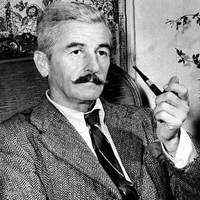Symbols in Faulkner's As I Lay Dying
Symbols are generally some objects, characters, figures, or colors used to represent abstract ideas or concepts. In As I Lay Dying, William Faulkner uses some significant symbols so that he can project the abstract ideas of his characters who do not communicate their feelings properly with other characters.

William Faulkner (1897-1962)
Animals are most used symbols in As I Lay Dying. Immediately after the death of Addie, her youngest son Verdaman compares her dead mother with the fish he has caught. The fish died when he caught and he relates the condition of his mother to the poor fish. Here the fish is the symbol of Addie for Verdaman. In the same way, for Darl, Jewel's horse is his mother. He finds the replica of Addie in the horse of Jewel and Jewel's love to her mother is presented through the love of Jewel to the horse. The cow which is swollen with milk is a symbol of Dewey Dell. She is taking the unwanted burden of pregnancy. The riding of Jewel on the horse stands for the freedom he has acquired from the Bundren Family. Moreover the bond between Jewel and the horse implicitly depicts is nature and attitude towards his mother Addie. Jewel is a byproduct of illicit relationship of Addie with the preacher, Whitfield. Jewel is characterized by violence as he is the result of Addie's violence of marital life, she sought this form of violence so as to feel alive. Jewel's monologue is rich in violent imagery. Whenever he walks around the house he walks fiercely in a rage and people are afraid of him. To show his love to mother he acts violently. It is he who saves his mother's coffin from the flood and from the fire. He cannot show his emotions of love in a proper manner except in a violent way. In this regard, the horse symbolizes the relationship of Jewel with mother and his own violent nature.
The coffin of Addie Bundren symbolically refers to the unnecessary burden of the family and at the same moment the dysfunctional family members. The coffin is made with great craft and care by Cash, but the moment Addie is placed in it, the burden of the family to take her to Jefferson for the burial starts. The last wish of Addie is too irrational in the context of the poor Bundrens since it was obvious to Addie that for them it is costly to travel up to Jefferson. Though Verdaman knows Addie cannot breathe, he makes holes in the coffin. The dead body of Addie is put upside down in the coffin. The imbalanced coffin in the river stands for the imbalance life of the Bundrens. No one in the family is mentally and emotionally balanced. Cash gets his leg fractured when he goes to rescue the coffin from the flood. Anse accompanies the coffin to Jefferson because he has a selfish motive to go there so that he can buy false teeth for him. The coffin becomes the gathering point for all of the family's dysfunction, and putting the coffin to rest is also crucial to the family's ability to return to some sort of normalcy in life and in mental state.
Another crucial symbol used in As I Lay Dying is the tools. There are two sorts of tools mentioned in the novel. They are Cash's carpentry tools and Anse's farm tools. These tools stand for the respectable living with self-dignity and the reckless handling of these tools refers to the instability in the lives of Bundrens. The carpentry tools are very important to Cash only at the first, but the moment it is lost in the river, whole family members venture for it search. Anse's farm tools are not mentioned in the novel, but in the end it becomes a great aid in their journey as Anse sells them to buy a new team of mules. This trade is major, as the money from Anse's stealing of Cash's gramophone fund and the sale of Jewel's horse represents the sacrifice of these characters' greatest dreams. Anse's farming equipment guarantees the family's livelihood and in an effort to the burial trip success, Anse endangers the very tools the family requires for survival.
Literary Spotlight
Introduction of As I Lay Dying
Plot Summary of As I Lay Dying
Themes in Faulkner's As I Lay Dying
As I Lay Dying a Masterpiece of Faulkner
Faulkner's As I Lay Dying as a Modern Text
Faulkner's Style in As I Lay Dying
Narrative Technique in Faulkner's As I Lay Dying
Multiple Voices and Perspectives in As I Lay Dying
 |
bachelorandmaster.com |